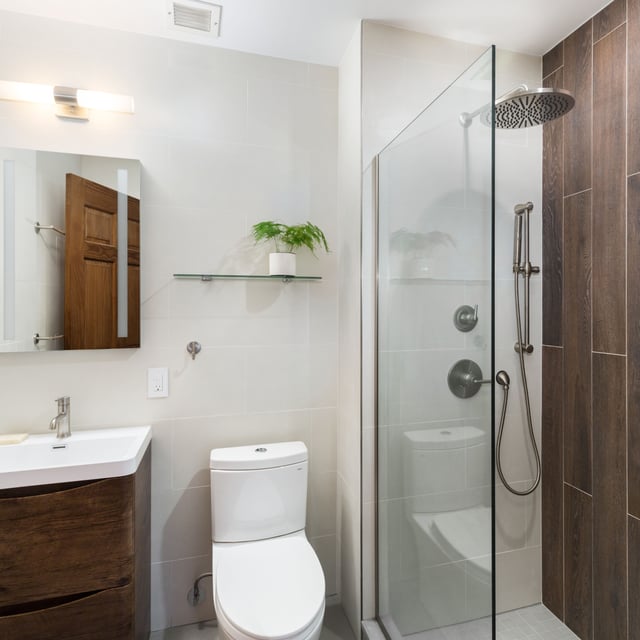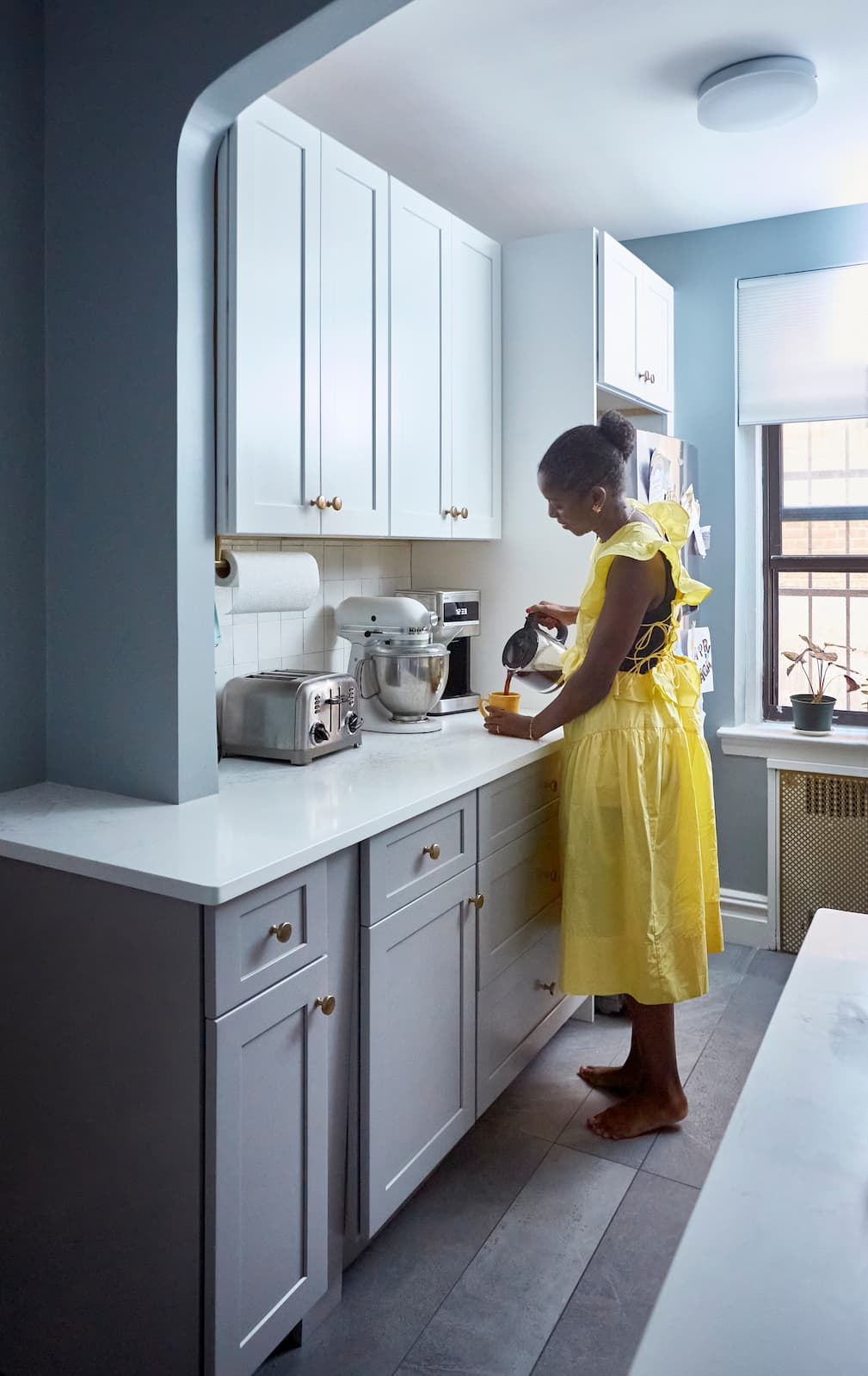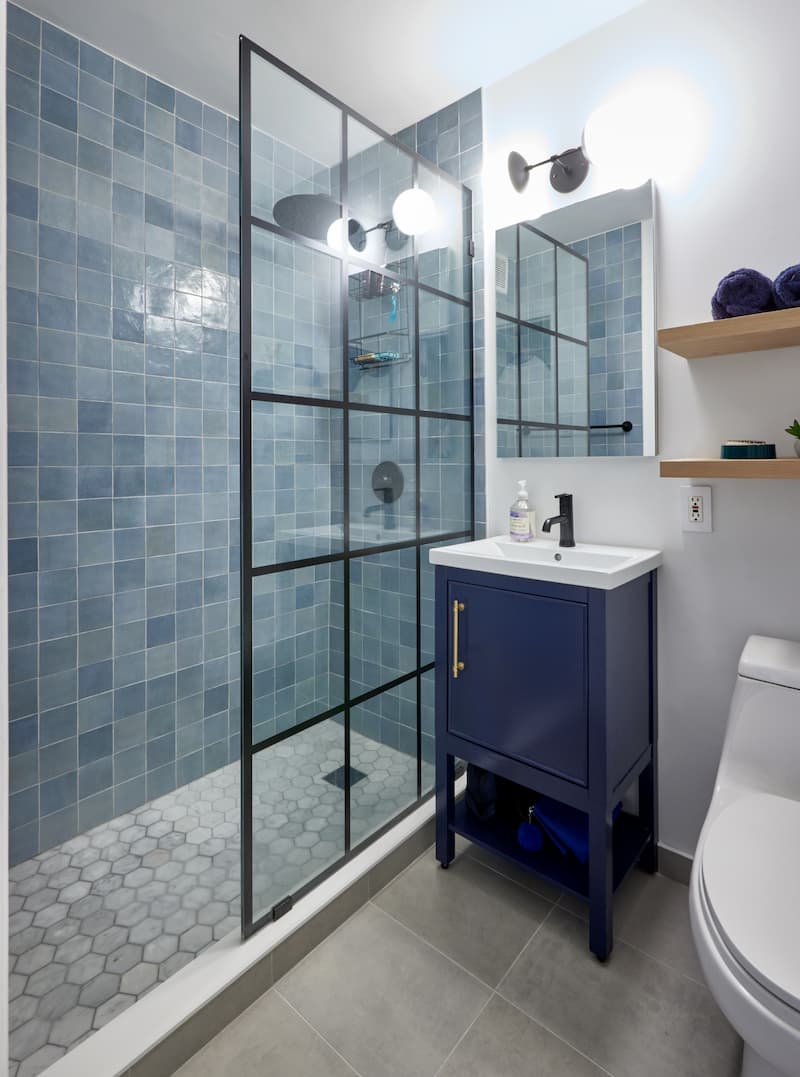What’s the ROI of a Bathroom Renovation?

In This Article
Bathroom renovations are practical and impactful home upgrades. As spaces used daily, bathrooms directly affect a home’s value and buyer appeal. For resale, a bathroom remodel can boost market value and attract more buyers. Renovating isn’t only about updates; it’s a strategic investment that increases property value. If you’re considering a remodel before selling, check out our guide on whether you should renovate before selling your home.
Return on Investment (ROI) is key for homeowners planning a bathroom upgrade. ROI isn’t just about recouping costs it measures how much value a remodel can add over time. For example, a homeowner who spends $20,000 on a remodel might expect a return of around $14,000 to $17,000, depending on market factors. This ROI percentage helps guide choices about budget and materials.
Below, we cover factors that impact ROI, remodel types and their typical returns, and upgrades that add the most value giving homeowners the clarity they need to make confident, informed renovation choices.
ROI for Bathroom Renovations
Defining ROI and Calculation
When planning a bathroom renovation, start by calculating the Return on Investment (ROI). ROI measures how much value a remodel adds to a home compared to its cost. The formula is:
| ROI = (Gain from Investment - Cost of Investment) / Cost of Investment |
For a bathroom remodel, "Gain from Investment" is the increase in home value due to the renovation, while "Cost of Investment" is the total expense of the project. For example, if a bathroom remodel costs $15,000 and adds $10,500 in value to the home, the ROI is 30%:
| ROI = (10,500-15,000)/15000 = 0.3 or 30% |
Factors Affecting ROI for Bathroom Renovations
Several factors impact the ROI of a bathroom renovation. Location is one of the biggest influences high-demand areas like California or New York tend to yield higher returns. The scope of the remodel is also important: a minor, budget-friendly update will result in a different ROI than a high-end remodel.
Material choices matter as well premium materials can increase the value of a renovation, while standard options might limit ROI. Knowing these factors helps homeowners plan projects with an ROI that fits their budget and local market.
Average ROI Ranges
The ROI on bathroom renovations typically ranges from 50% to 75%. Minor remodels often deliver higher returns as they involve a smaller upfront investment and focus on cost-effective, impactful upgrades.
Upscale remodels may reach an ROI of 55% to 60%, offering strong appeal in the high-end market. Knowing these average ranges helps homeowners set realistic expectations for the financial impact of their project.
Factors That Impact the ROI of a Bathroom Renovation
Quality of Materials and Fixtures
The materials and fixtures used in a bathroom remodel directly impact ROI. Premium options like natural stone, marble countertops, and designer fixtures add appeal but come with a higher cost. These choices may yield a lower percentage ROI but can attract buyers willing to pay more for these features.
On the other hand, standard, durable materials like ceramic tiles or quartz countertops are more budget-friendly and can still provide solid ROI, making them a popular choice for midrange remodels.
Type of Renovation (Cosmetic vs. Full Remodel)
Not all renovations bring the same ROI. Cosmetic upgrades—like updating lighting, painting, and replacing hardware are affordable and can make a bathroom look updated.
These minor changes usually deliver a high ROI, especially for homeowners planning to sell soon. Full remodels, which may include layout changes, plumbing upgrades, and premium finishes, are more costly.
However, they often deliver strong returns for those looking to increase home value and improve functionality over the long term.
Regional Market Trends
Real estate markets differ widely across regions, and so does the ROI of a bathroom renovation. In high-demand areas like the Pacific region, homeowners can generally expect a higher return.
Regions with lower demand or where buyers place less importance on upgraded bathrooms may see a lower ROI. Doing market research or consulting with a local real estate agent can help homeowners understand how much value a bathroom remodel could add in their area.
Energy-Efficient and Eco-Friendly Upgrades
Sustainable choices are popular and can improve ROI. Energy-efficient upgrades like low-flow toilets and water-saving showerheads attract environmentally-conscious buyers and help lower utility costs.
Using eco-friendly materials like bamboo flooring or reclaimed wood vanities can also make a home more marketable. Though these upgrades may have higher upfront costs, they offer long-term savings and often lead to higher ROI in areas where buyers value sustainable features.
Age and Condition of the Home
The age and condition of a home affect the ROI of a bathroom remodel. In older homes, renovations that address structural or plumbing issues can add value by resolving concerns potential buyers may have.
In newer homes, where bathrooms are already functional and up-to-date, extensive renovations might lead to a lower ROI since fewer upgrades are necessary. Homeowners should assess their property’s current state to decide whether a minor update or a complete remodel makes the most financial sense.
Average ROI for Different Types of Bathroom Renovations
Minor Bathroom Remodel
A minor bathroom remodel is a budget-friendly way to update a bathroom without a full renovation. Common updates include replacing faucets and shower heads, updating cabinet hardware, installing a new mirror, and adding a fresh coat of paint. These small adjustments improve the bathroom’s look without extensive work, making it a popular choice for homeowners aiming to increase ROI.
The ROI for minor bathroom remodels is often high, typically ranging from 70% to 80%. These updates don’t require a large budget but can make the bathroom more appealing to buyers. Minor remodels are especially valuable in older homes where bathrooms may look dated. Simple changes like updating light fixtures or installing a new vanity can help attract buyers without significant expense.
Midrange Bathroom Remodel
A midrange bathroom remodel includes moderate upgrades that improve both functionality and appearance. This remodel might include replacing floors with ceramic tiles, installing a new vanity with a solid-surface countertop, upgrading to energy-efficient lighting, and adding standard chrome or brushed-nickel fixtures. These upgrades add comfort and durability, making the bathroom more appealing to both homeowners and future buyers.
The average ROI for a midrange bathroom remodel is around 60% to 70%. While the upfront cost is higher than a minor remodel, midrange upgrades attract a broader range of buyers. In markets where updated bathrooms are in high demand, these upgrades can boost the home’s resale value. Adding water-efficient toilets and faucets, for example, appeals to eco-conscious buyers and adds long-term value..
Upscale Bathroom Remodel
An upscale bathroom remodel upgrades a standard bathroom into a more premium experience. This type of remodel includes materials like marble or natural stone for floors and countertops, custom cabinetry, frameless glass shower enclosures, and features such as rain showers and dual-flush toilets. Other additions often include heated floors, LED lighting, and smart shower controls.
Upscale remodels generally yield an ROI of 50% to 60%. While this percentage is lower than that of smaller upgrades, upscale remodels appeal to high-end buyers willing to pay more for premium features. These remodels are especially beneficial in high-demand areas where luxury is in demand, such as major urban centers or affluent neighborhoods.
Addition of a New Bathroom
Adding a new bathroom is a large project, but it can offer strong returns, especially in homes where the number of bedrooms outweighs the number of bathrooms. A bathroom addition often involves building a full-sized bathroom with a shower, vanity, and toilet in an area previously used for storage or other non-essential purposes. This is particularly useful in family homes where additional bathrooms provide more functionality and convenience.
The ROI for adding a bathroom generally ranges between 50% and 60%, though it may be higher in areas with strong demand. A bathroom addition appeals to buyers looking for added convenience and is valuable in competitive real estate markets. For more information on costs and considerations, see our guide on the costs of adding a bathroom to a house.
Bathroom Renovation Upgrades That Add Value
Updating Fixtures and Hardware
Replacing old fixtures and hardware is one of the easiest and most affordable ways to update a bathroom, adding value without extensive renovation. Installing new faucets, showerheads, and cabinet handles gives the bathroom a more modern look while maintaining functionality. Popular finishes include brushed nickel, matte black, and chrome, which work well with various bathroom setups.
Upgrading fixtures can boost ROI by creating a fresh, coordinated look. Even in smaller remodels, modern fixtures add appeal and signal to buyers that the home has been thoughtfully updated. Many newer fixtures also offer water-saving options, a bonus for environmentally conscious buyers.
Upgrading shower fixtures, for instance, is a valuable change that doesn’t require a full remodel. For more details on pricing, see our guide on shower installation costs.
Upgrading Flooring and Tile
Flooring is a key feature in a bathroom, and updating it can improve both appearance and function. Popular choices include ceramic and porcelain tiles, which are durable and water-resistant. For high-end remodels, natural stone tiles like travertine or marble offer a more premium option, though they come with a higher price tag.
Upgraded flooring adds durability and appeals to buyers looking for quality materials. This upgrade can provide a solid ROI by combining lasting value with practical benefits. Choosing neutral, timeless colors ensures the bathroom will appeal to a wide range of buyers.
Improving Lighting and Ventilation
Proper lighting and ventilation are essential for a functional bathroom. Upgrades in these areas can add value and improve the bathroom’s usability. Lighting choices like recessed lighting, wall sconces, and LED fixtures create a well-lit, inviting environment, while ventilation improvements help prevent moisture buildup and related issues like mold.
Ventilation upgrades, such as adding a window or installing a new exhaust fan, maintain air quality and help protect the bathroom’s structure. Both lighting and ventilation upgrades are budget-friendly options with solid ROI potential. For tips on optimizing layouts in smaller bathrooms, visit our guide on maximizing small bathroom spaces.
Installing Energy-Efficient Toilets and Showers
Eco-friendly bathrooms are increasingly popular, as energy-efficient fixtures help lower utility bills and conserve resources. Low-flow toilets, water-saving showerheads, and motion-sensor faucets are smart choices that appeal to environmentally conscious buyers. These upgrades make a bathroom more sustainable and meet energy standards many buyers prioritize.
Adding energy-efficient features may involve higher upfront costs but provides ongoing savings and a solid return on investment. In competitive markets, these upgrades can help a home stand out, potentially leading to a faster sale and a stronger offer.
Adding Luxurious Features (Heated Floors, Walk-in Shower)
For homeowners seeking a high-end bathroom, adding features like heated floors, a frameless walk-in shower, or a soaking tub can make a strong impression. While these upgrades don’t always guarantee a high percentage ROI, they often attract buyers who appreciate quality and comfort.
Heated floors, especially popular in colder climates, add both warmth and convenience. Walk-in showers with rainfall showerheads or dual controls create a spa-like feel and can add appeal. Luxury features like these attract buyers looking for a retreat-like bathroom and can help justify a higher asking price, even if the ROI percentage is lower.
For more ideas on creating a spa-like bathroom, see our ensuite bathroom ideas and inspiration guide.
Calculating Your Bathroom Renovation ROI
Step-by-Step Guide for Estimating ROI
Calculating the ROI of a bathroom renovation can give homeowners a clearer sense of the potential financial benefits. Here’s a simple, actionable formula to estimate ROI:
| ROI = (Gain from Investment - Cost of Investment) / Cost of Investment × 100 |
Step 1: Determine the Cost of Investment
Add up all expenses for the bathroom remodel, including materials, labor, permits, and any other fees.
Step 2: Estimate the Gain from Investment
Check local listings for homes with recently renovated bathrooms and compare their sale prices to homes without updates. This can give a rough estimate of how much value a remodel might add.
Example Calculation:
Suppose you spend $15,000 on a midrange bathroom remodel, and local listings indicate that this could raise your home’s resale value by around $10,500. Using the formula:
| ROI = (10,500-15,000/15,000) × 100 = 70% |
In this case, the ROI is 70%, meaning you recover a substantial portion of the investment while adding to the home’s value.
Assessing Your Market and Home Value
To get the most ROI from a bathroom remodel, start by understanding your local market and your home’s current value. You can estimate this value using online tools or by consulting a real estate agent. Next, look at similar properties in your area, especially those with recently renovated bathrooms, to see how these updates affect their selling price.
In high-demand areas, buyers often look for homes with modern, updated bathrooms, which can lead to higher returns on renovations. In areas with lower demand, large renovations may bring a smaller ROI. By aligning remodel choices with your market’s needs, you’re more likely to meet buyer expectations and add value to your home.
Choosing a skilled contractor is also essential to a reliable remodel. For advice on selecting the right professional, see our article on how to choose a bathroom contractor.
Cost vs. Value Report Resources
Annual reports like Remodeling Magazine’s Cost vs. Value Report help homeowners plan renovations by showing regional and national averages for the costs and resale values of common projects, including bathroom remodels. Homeowners can use this data to see typical ROIs for different types of renovations in their area.
For example, a midrange bathroom remodel might yield a 60% return in one region but 75% in another. By referencing these reports, homeowners can set realistic expectations based on proven data and plan renovations that match local market trends.
Budgeting for a remodel can feel overwhelming, but financing options are available. For guidance, see our Ultimate Guide to Bathroom Remodel Financing.
Pros and Cons of a Bathroom Renovation for ROI
Pros of Renovating a Bathroom for ROI
- Increased Home Value: A well-planned bathroom renovation can boost a home’s value. Buyers often see updated bathrooms as a sign of care and attention, making the property more appealing and marketable.
- Improved Functionality: Bathroom remodeling can solve layout issues, add storage, or improve fixtures. A more practical and efficient bathroom can be a strong selling point and make daily routines easier for homeowners.
- Broader Market Appeal: Updated bathrooms attract a wide range of buyers, especially in competitive markets. Features like energy-efficient fixtures, durable materials, and neutral designs can make a home more appealing to potential buyers who value these updates.
- Energy Efficiency and Sustainability: Energy-saving upgrades like low-flow toilets, efficient showerheads, and eco-friendly materials help lower utility costs and appeal to environmentally conscious buyers. Sustainable renovations can also add to the home’s value and contribute to long-term savings.
- Higher Sales Potential: Homes with updated bathrooms often sell faster than those with outdated ones, especially in markets where buyers want modern, move-in-ready properties. A bathroom remodel can give your home a competitive edge and lead to a quicker sale.
Cons of Renovating a Bathroom for ROI
- High Upfront Costs: Bathroom renovations, especially full remodels or high-end upgrades, can be costly. Between materials, labor, and permits, these upfront expenses may not always be fully recovered, particularly in areas where buyers are less likely to pay a premium for luxury features.
- Time Commitment: Even minor bathroom renovations can take several weeks, with upscale remodels often taking longer. Homeowners may need to adjust routines or handle disruptions if the work is happening in a frequently used bathroom.
- Market Volatility: ROI depends on market conditions, which can shift over time. If the market declines, the added value from a bathroom renovation may be less than expected, which can lower ROI and affect resale value.
- Risk of Over-Improvement: Some extensive or high-end remodels may surpass the typical value expectations for a neighborhood. When a bathroom remodel isn’t in line with the home’s value or the area, it may result in a lower ROI as resale value is limited by the local market.
- Possibility of Unexpected Expenses: Renovation projects can sometimes reveal hidden issues like plumbing leaks, mold, or electrical problems. These unexpected repairs can quickly increase the total cost of the renovation and reduce ROI..
Maximizing Your ROI: Expert Tips
Choose Timeless, Neutral Designs
Choosing neutral, timeless designs is one of the most effective ways to maximize ROI in a bathroom renovation. Colors like white, beige, gray, and soft pastels appeal to a broad range of buyers and create a clean, open look. These colors make it easier for buyers to envision their own preferences in the space.
Classic elements, such as subway tiles, simple cabinetry, and basic fixtures, keep the bathroom from looking outdated and help protect the investment. By avoiding bold trends that may lose popularity, homeowners maintain the bathroom’s appeal over time. Neutral, timeless choices are especially helpful for homeowners planning to sell, as they suit a variety of tastes and help increase the return on renovation.
Hire Experienced Professionals
The workmanship of a bathroom renovation directly affects its ROI. Hiring experienced professionals such as licensed contractors, plumbers, and electricians ensures work is done right. Skilled contractors handle complex tasks, manage unexpected challenges, and keep projects on schedule, creating a smoother process for homeowners. Poor-quality work or improper installations can lead to costly repairs later and lower the value of the renovation.
Experienced professionals also offer useful insights and suggestions that improve the bathroom’s functionality. They often have access to reliable materials and efficient practices that lead to a polished outcome. While hiring skilled professionals may raise initial costs, this investment often brings lasting value, supporting the home’s appeal to future buyers.
Focus on Energy-Efficient and Sustainable Features
Adding energy-efficient and sustainable features to a bathroom remodel can increase ROI while making the home more appealing to today’s buyers. Upgrades like low-flow toilets, water-saving showerheads, and LED lighting help reduce utility bills and attract environmentally conscious buyers. Choosing energy-efficient fixtures offers homeowners a way to reduce water and energy use without sacrificing quality.
Using sustainable materials, like recycled glass countertops or bamboo flooring, can also boost appeal in competitive markets that value eco-friendly homes. Although these upgrades may involve a higher upfront cost, they offer long-term returns by adding resale value and cutting down on maintenance costs. Eco-conscious choices can make a lasting impact on value and utility bills. For small-space efficiency ideas, refer to our guide on minimum bathroom size and maximizing space.
Conclusion
A bathroom renovation is more than a simple upgrade—it’s a smart investment with real financial returns. From minor updates to full remodels, bathroom improvements increase a home’s appeal, function, and resale value. Focusing on ROI, selecting upgrades that meet market expectations, and choosing durable, sustainable options can help homeowners make renovation decisions that maximize their return.
Balancing costs with potential returns requires careful planning and an understanding of what today’s buyers want. Neutral designs, experienced professionals, and eco-friendly features are practical strategies that not only boost ROI but also add lasting value to the home.

Written by Block Renovation
Frequently Asked Questions
Are there specific bathroom features buyers look for that improve ROI?
Can DIY bathroom updates affect ROI compared to hiring professionals?
How can I make a small bathroom remodel profitable in terms of ROI?
Which bathroom upgrades have the highest ROI?

Renovate confidently with Block
Easily compare quotes from top quality contractors, and get peace of mind with warranty & price protections.
Thousands of homeowners have renovated with Block

4.5 Stars (100+)

4.7 Stars (100+)

4.5 Stars (75+)
Renovate confidently
- Top quality contractors
- Warranty & price protections
- Expert resources

